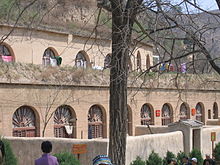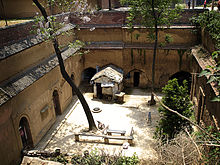- Yaodong
-
Un yaodong (窑洞 ; pinyin : yáo dòng), ou « maison-grotte », est une forme particulière de construction servant d'habitation, commune dans le plateau de Lœss en Chine du Nord, caractérisée par une structure en voûte de plein cintre. Certaines de ces constructions, creusées dans le lœss, sont totalement ou partiellement troglodytiques, d'autres sont construites sur terrain plat, la voûte étant alors de briques de terre crue (adobes).
Cité troglodyte à Yan'an (Shaanxi) où ont résidé les dirigeants du Parti communiste chinois pendant la Longue Marche
Sommaire
Répartition géographique
 Le plateau de Lœss en Chine du Nord (zone hachurée) et la vallée du Huang He (Fleuve Jaune)
Le plateau de Lœss en Chine du Nord (zone hachurée) et la vallée du Huang He (Fleuve Jaune)
Les yaodong sont des habitations communes sur le plateau de Lœss de la Chine du Nord ; on les trouve principalement dans quatre provinces : le Gansu, le Shaanxi, le Shanxi et le Henan, ainsi que dans la région autonome hui du Ningxia.
C'est notamment dans la région de Qingyang, à l'extrême est de la province du Gansu, que l'on trouve la plus forte proportion d'habitations souterraines de toute la Chine[1].
Les différents types de yaodong
On peut distinguer deux types de yaodong souterrains :
- ceux creusés dans les escarpements de lœss, à flanc de vallée : un exemple typique en est la cité troglodyte de Yan'an ;
- ceux creusés autour d'une excavation réalisée à la surface du plateau, servant de cour intérieure, dits yaodong en puits (photo ci-contre).
Il existe également des yaodong construits totalement ou partiellement à l'extérieur, avec une structure en voûte de plein cintre inspirée des habitations souterraines ; la construction de yaodong souterrains n'étant plus autorisée, les nouvelles habitations de ce type, à voûtes d'adobes, sont désormais fréquentes chez les fermiers de la région[2].
Origines des yaodong
Les premières habitations souterraines de type yaodong dateraient du IIe millénaire av. J.‑C., correspondant en Chine à l'âge du bronze et, selon la tradition chinoise, à la dynastie Xia. Les chercheurs chinois estiment généralement que ce type d'habitat s'est développé surtout à partir de la dynastie Han (-206 à 220), parallèlement à une amélioration progressive des techniques de construction jusqu'aux dynasties Sui (581 à 618) et Tang (618 à 907). C'est cependant au cours des dynasties Ming (1368 à 1644) et Qing (1644 à 1912) que leur rythme de construction atteint son apogée[3].
Techniques de construction
Sources
- (fr) Caroline Bodolec, L'architecture en voûte chinoise, Maisonneuve & Larose, 2005 (ISBN 2-7068-1844-1) (aperçu limité en ligne)
- (en) Gideon Golany, Chinese earth-sheltered dwellings, University of Hawaii Press, 1992 (ISBN 0-8248-1369-3) (aperçu limité en ligne)
- (fr) École des hautes études en sciences sociales, « Le Shaanbei, pays des maisons-grottes ». Consulté le 13 juillet 2009
- (fr) Chine Informations, « Yaodong ». Consulté le 13 juillet 2009
Notes et références
- « In the Qingyang region especially, the ratio of cave dwellers to non-cave dwellers is the highest found anywhere in China. », Chinese earth-sheltered dwellings, Gideon Golany, op. cit., p. 44
- « Recently, construction of new pit cave dwellings was officially forbidden and currently only aboveground structures are being approved as new dwellings. As a result, many farmers of the region today are constructing aboveground earth-sheltered habitats (yantu jianzhu) that have a vaulted adobe brick arch covered by a tile roof. », Chinese earth-sheltered dwellings, Gideon Golany, op. cit., p. 51
- « Thus, cave dwellings in China probably appeared during the Xia dynasty, which can be characterized as a Bronze Age culture that flourished around the beginning of the second millenium B.C. However, it is assumed among Chinese researchers that widespread construction of cave dwellings became only during the Han dynasty (206 B.C.—A.D. 220) and that cave-building techniques reached a mature stage only by the time of the Sui (A.D. 581—618) and Tang (618—907) dynasties. The large-scale proliferation of cave dwellings in the loess soil zone did not occur, however, until the period of the Ming and Qing dynasties (1368-1911). », Chinese earth-sheltered dwellings, Gideon Golany, op. cit., p. 5-7
Voir aussi
Articles connexes
Liens externes
- (en) Chinese Cave Dwellings Inspire Sustainable Design, AllAmericanPatriots.com
- (fr) Le village de Dazhai (Shanxi), CCTV : le documentaire présente les yaodong du village de Dazhai dans sa 3e partie (de 12 min 34 à 16 min 53)
- Portail de la Chine
- Portail de l’architecture et de l’urbanisme
Wikimedia Foundation. 2010.


